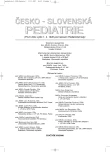Aspirated Foreign Bodies in Children
Authors:
K. Bartoňková
Authors‘ workplace:
Dětská ORL klinika FN Brno
přednosta prof. MUDr. I. Šlapák, CSc.
Published in:
Čes-slov Pediat 2008; 63 (1): 19-23.
Category:
Original Papers
Overview
Introduction:
Aspiration of a foreign body represents a life-threatening condition, which requires an immediate surgical intervention. The most often affected children are at their age of one to three years (80% of cases). The foreign body causes respiratory distress, cyanosis, pain, intermittent hoarseness and/or vomiting, which can be followed by asymptomatic period of time and bronchopulmonary complications.
Materials and methods:
the observed cohort is constituted by patients who have been treated at the Clinic of Children ORL, Medical Faculty, Masaryk University at Brno. The period of observation was since the year 2000 till 2005. A total of 135 patients were treated for suspected foreign bodies, 75 of them boys and 60 girls.
Results:
In 12 patients bronchoscopy was not performed for uncertain anamnesis, negative ORL and internal examination and negative X-ray finding. In one case the patient coughed out a candy (sweet) during the ORL examination. Bronchoscopy was performed in 123 patients.
Discussion:
Subglottic laryngitis is the most frequent cause of choking in children as well as an aspirated foreign body and epiglottitis. A rapid disclosure and therapy of the threatening respiratory distress is important for a good prognosis and minimization of the risk of complications. In patients who have been repeatedly hospitalized for respiratory problems the foreign body should be suspected. For the establishment of diagnosis, history is of importance as well as internal examination, ORL finding and imaging methods.
Conclusion:
Prevention is of importance as well as continuous information for parents about possible risk and giving proper attention to this kind of warning. In cases of suspected foreign body in respiratory pathways a rapid diagnosis is necessary as well as removal of the foreign body.
Key words:
bronchoscopy, aspirated foreign bodies
Sources
1. Brett CM, Zwas MS, France NK. Eyes, ears, nose, throat and dental surgery. In Pediatric Anesthesia. Churchill Livingstone, 1994: 657–697.
2. Ansari MM, Haleem S, Shakoor A. Foreign bodies in airway: Problems and management. Asian Crit. Care Med. 1998;48: 45–41.
3. McRae K. Anesthesia for airway surgery. Anesthesiol. Clin. North Am. 2001;19: 515–519.
4. Chrobok V, Růžička J, Dufek Z, Vokurka J. Cizí tělesa v dýchacích a polykacích cestách. Choroby hlavy a krku 1998;2: 13–16.
5. Weissberg D, Schwartz I. Foreign bodies in the tracheobronchial tree. Chest 1987;91: 730–733.
6. Pinto A, Scaglione M, Pinto F. Tracheobronchial aspiration of foreign bodies: current indications for emergency plain chest radiography. Radiol. Med. 2006;25: 101–103.
7. Midulla F, Guidi R, Barbato A, Capocaccia P. Foreign body aspiration in children. Pediatr. Int. 2005;47(6): 663–668.
8. Basek P, Wildhaber J. The child with dyspnoea. Ther. Umsach. 2005;62(8): 525–531.
9. Robinson PJ. Laryngeal foreign bodies in children: first stop efore the right main bronchus. J. Pediatr. Child Health 2003;39(6): 477–479.
10. Caglayan S, Erkin S, Fotelu I, Oniz H. Bronchial foreign body vs astma. Chest 1989;96(3): 509–511.
11. Aebi U. Suffocation attack. Schweiz. Med. Wochenschr. 1993;123(16): 767–774.
12. Lima JA. Laryngeal foreign body bodies in children: a persistant, life-threatening problem. Laryngoskope 1989;99(4): 415–420.
13. Yildizeli B, Tonuti F, Yuksel M, et al. Effects of intrabronchial foreign body retention. Pediatr. Pulmonol. 2002;33(5): 362–367.
14. Kosucu P, Ahmetoglu A, Koramay I, et al. Low-dose MDCT and virtual bronchoscopy in pediatric patient with foreign body aspiration. Am. J. Roentgenol. 2004;183(6): 177–187.
15. Adaleti I, Kurugoglu S, Ulus S, et al. Utilization of low-dose MDCT and virtual bronchoscopy in children with suspected foreign body aspiration. Pediatr. Radiol. 2007;37(1): 33–40.
16. Ramirez-Figueroa JL, Gochicoa-Ragel LG, Ramirez-San Juan DH, Vargas MH. Foreign body removalby flexible fiberoptic bronchoscopy in infants and children. Pediatr. Pulmonol. 2005;40(5): 392–397.
17. Swanson KL. Airway foreign bodies: what’s new? Sem. Respir. Crit. Care Med. 2004;25(4): 405–411.
18. Wood RE, Postma D. Endoscopy of the airway in infants and children. J. Pediatr. 1988;112: 1–6.
19. Vane DW, Pritchard J, Colville CW. Bronchoscopy for aspirated foreign bodies in children. Arch. Surg. 1998;123: 885–888.
Labels
Neonatology Paediatrics General practitioner for children and adolescentsArticle was published in
Czech-Slovak Pediatrics

2008 Issue 1
- What Effect Can Be Expected from Limosilactobacillus reuteri in Mucositis and Peri-Implantitis?
- The Importance of Limosilactobacillus reuteri in Administration to Diabetics with Gingivitis
Most read in this issue
- Aspirated Foreign Bodies in Children
- Early Diagnostics of Asperger Syndrome and Specific Aspects
- Neural Tube Defects – Current Opinion on Etiopathogenesis and Prevention Potencial of Folic Acid
- Transcutaneous Bilirubinometry in Preterm Newborns
